Dental implants
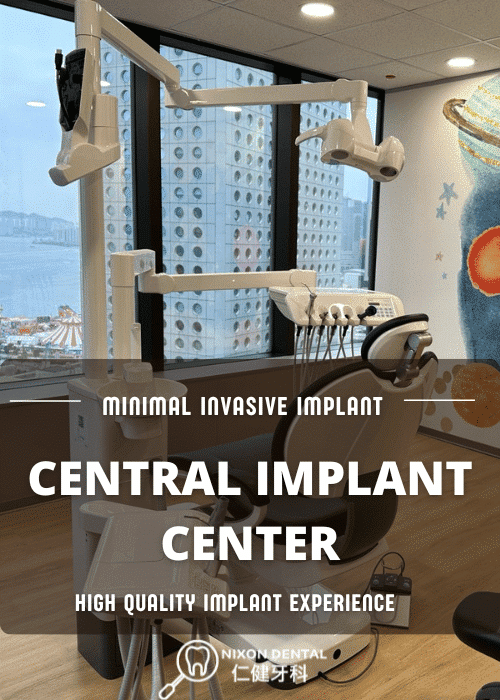
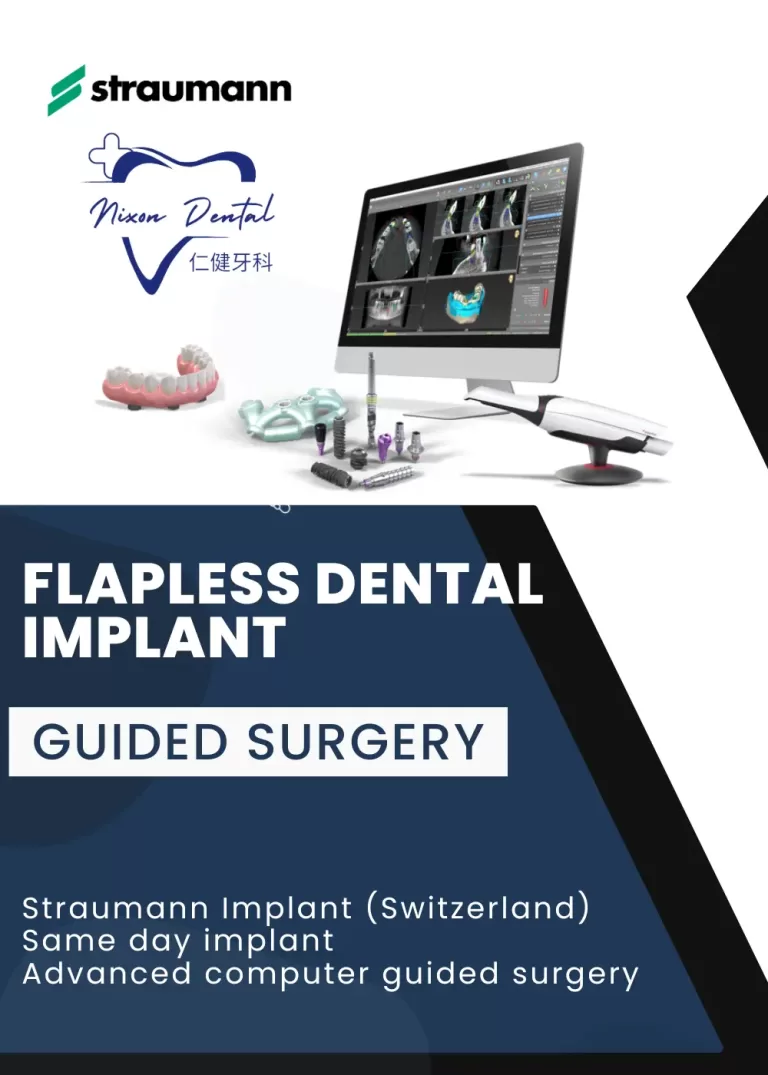
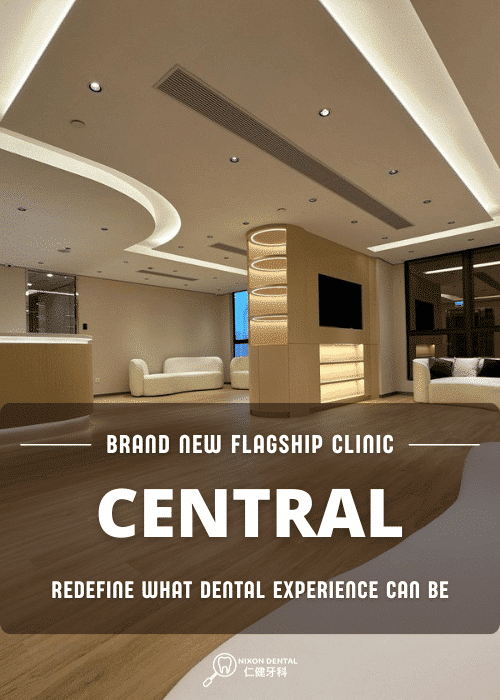
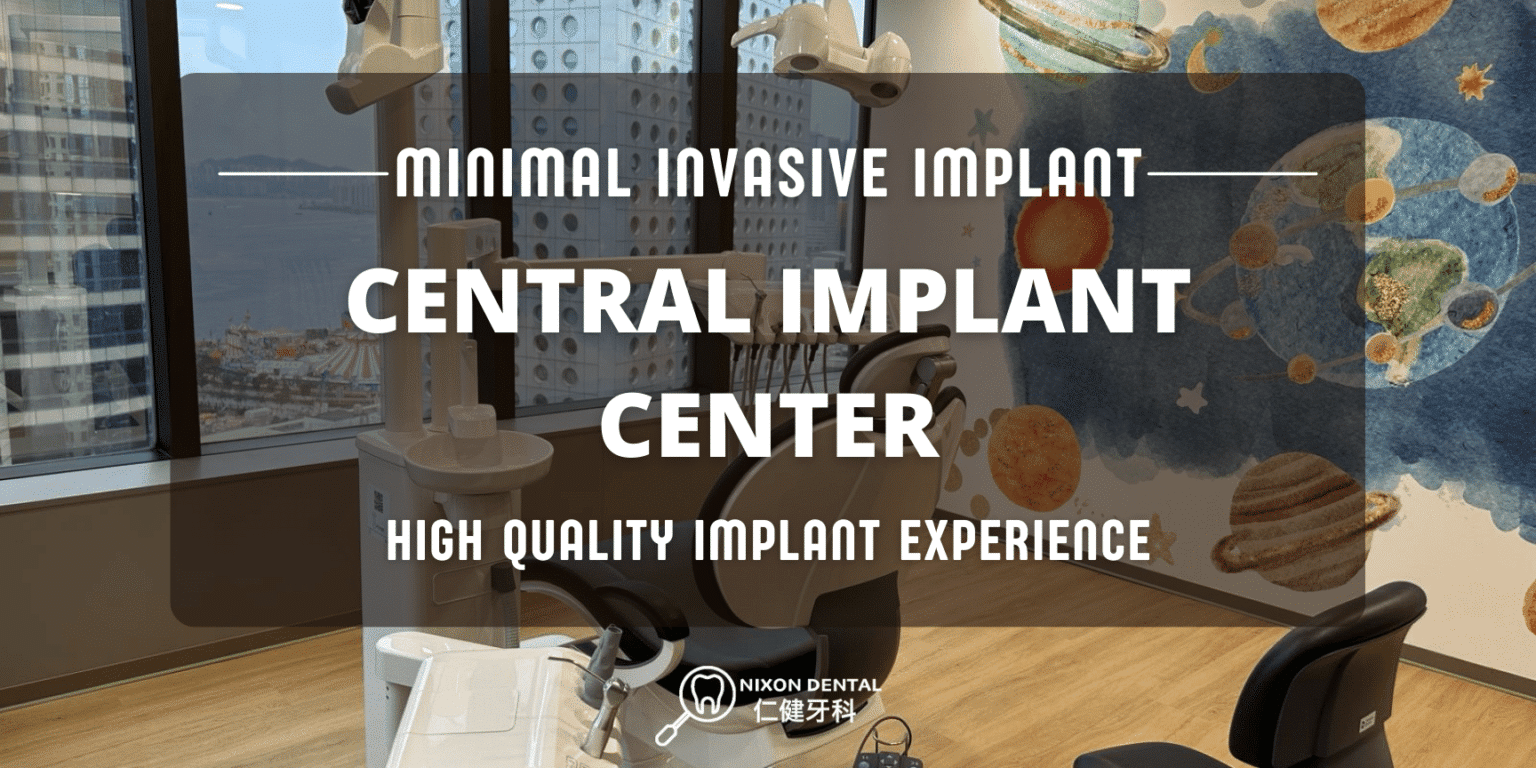

Cost of Dental Implants
A single dental implant costs $18,000
If two or more dental implants are performed, the fee is $15,000 each
The price includes consultation, computed tomography (x-ray), implant surgery, other materials and artificial crowns.
| Implant Brand | Company based in | Number of Implants | Cost per Implant |
|---|---|---|---|
| Osstem | Korean | Single | $18000 |
| More than one | $15000 | ||
| Hiossen | USA | Single | $20000 |
| More than one | $17000 | ||
| Straumann | Switzerland | Single | $25000 |
| More than one | $22000 |
Understanding Dental Implants: A Brief Overview
Dental implants are prosthetic replacements for missing teeth, designed to mimic the natural tooth structure. Unlike traditional dentures, implants offer a permanent and stable solution, enhancing not only the functionality of the mouth but also the overall quality of life. Implants consist of a titanium post surgically placed into the jawbone, serving as a sturdy foundation for the attachment of artificial teeth.
Maintaining good dental health is imperative for overall well-being. Dental issues not only affect the ability to chew and speak but can also impact confidence and social interactions. Dental implants play a pivotal role in restoring not just the physical aspects of a smile but also the emotional and psychological facets of an individual’s life.
By preventing the shifting of adjacent teeth and preserving jawbone density, dental implants contribute significantly to oral health. They aid in maintaining the natural alignment of teeth, reducing the risk of complications such as temporomandibular joint (TMJ) disorders.
Reasons for having dental implants
As the population ages, the demand for dentistry and the demand for dental services is getting higher and higher. In the past, elderly people often replaced lost teeth with removable dentures, but since the advent of dental implant technology, more people choose to repair their lost chewing function in this way. Since dental implants use alveolar bone as their support, they are more similar to the design of human teeth than other replacement methods, and they are certainly more comfortable to use.
Why should you choose dental implants? The implant is surgically placed in your cheekbone, and because the titanium in the implant fuses with your cheekbone, the implant will not be loosen, create unfavorable noise, or damage the bone like dentures, and the material will be better and less prone to abrasion. This is the advantage of this dental implant surgery and is recommended by implant dentists.
Benefits of dental implants
Dental implants are a type of fixed replacement. Compared with removable dentures, fixed dentures are more stable and comfortable, do not need to be removed frequently, and have a stronger bite force, so that most patients with missing teeth want to replace their missing teeth by fixed replacement.
In addition to dental implants, there is also another fixed denture – the bridge. Since dental bridges are also fixed dentures, so they are stable and comfortable, but bridges need to rest on the teeth next to them, so some of the enamel of the neighboring teeth needs to be trimmed and this process will weaken the teeth and may lead to increased tooth sensitivity
Therefore, if the medical condition and the bone conditions of the patients are favorable, most patients will prefer dental implants to repair missing teeth.
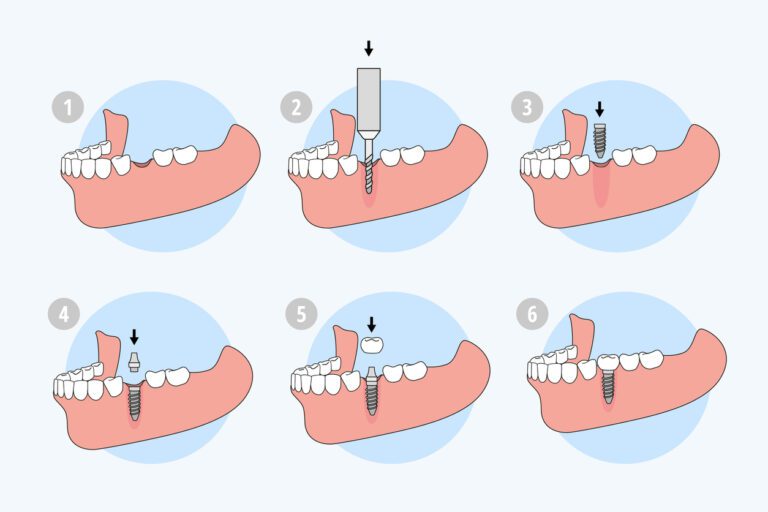
Procedures of dental implants surgery
Depending on the type of implant and the condition of your jaw, there are usually 3 stages of implant surgery:
1) Embedding the implants into the alveolar bone
During the surgery which the implant is placed into the bone, the dentist will cut the gum and elevate it. A small hole is then drilled in a predetermined position to place the dental implant, which is used as the root of the tooth.
2) Waiting for healing
After the metal root is implanted into your cheekbone, the alveolar bone will slowly heal with the implant, and this process will take about 3 months. The dentist will then put a healing cap onto the implant for the gum to heal around.
3) Screwing-in or cementing the crown / bridge
When the gums have healed, the dentist will remove the gum healing cap on the implant, take an impression, and then make a crown that looks and functions like a real tooth.
What is minimally invasive dental implants?
With the rapid development of dental implant technology, more people will choose computer-navigated minimally invasive dental implants. First of all, you need to know the surgical principle of dental implants: in the past, doctors generally relied only on two-dimensional X-rays such as Periapical radiograph and Orthopantomogram (OPG). Therefore, most dental implant surgery requires cutting the gum and exposing the tooth bone to accurately perform dental implant surgery.
However, procedures such as cutting the gum not only increase the swelling and pain after surgery, but also require longer operation time, and stitches are required after surgery. Many patients are deterred from dental implants for fear of the discomfort of surgery. Minimally invasive dental implants have come into being in the hope that dental implants can be implanted in a less invasive way to improve their patients’ feeding ability and aesthetics.
Minimally invasive dental implants eliminate the need to cut the gum to expose the bone, resulting in shorter operation times, less postoperative discomfort and no need for stitches in wounds.
The computer-navigated, minimally invasive dental implant procedure is to take a CT scan (Cone Beam Computed tomography) for the patient to accurately understand the position and width of the alveolar bone, and then put the precise surgical template into the mouth to accurately perform the operation.
However, not all patients are candidates for minimally invasive dental implants. If the width and height of the tooth bone are insufficient, traditional dental implant surgery may be required, combined with bone augmentation surgery. If you have any questions, please consult a registered dentist.
Steps for minimally invasive dental implants
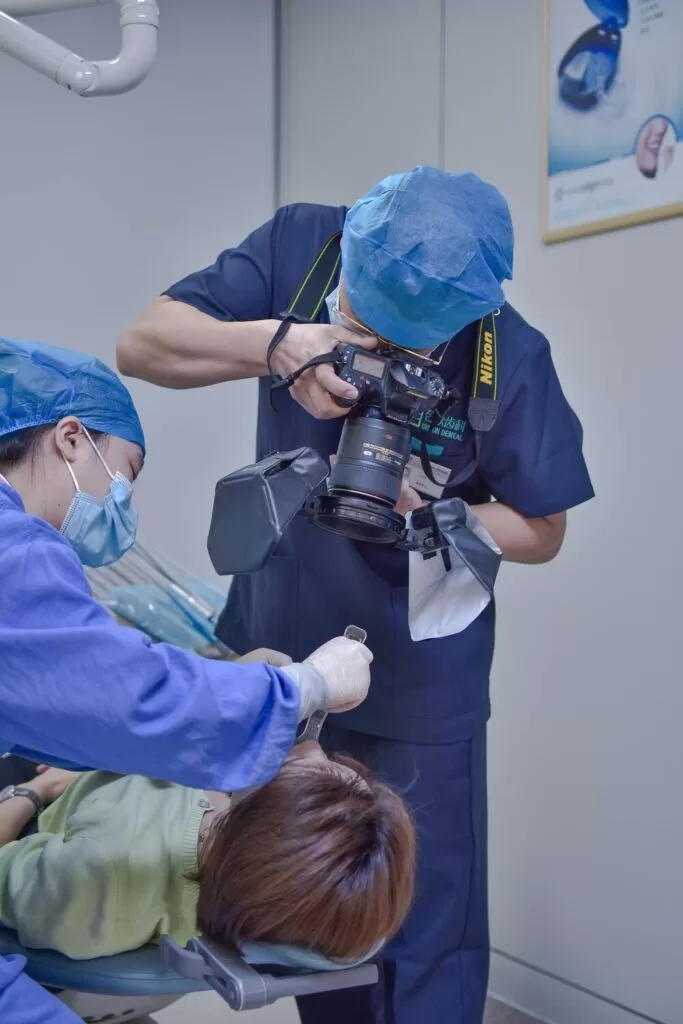
Comprehensive oral examination
Your doctor will first perform a comprehensive oral examination, including tooth decay and preliminary periodontal disease examination, to ensure that other dental problems are not overlooked. The doctor will then take a picture of your mouth for your records.
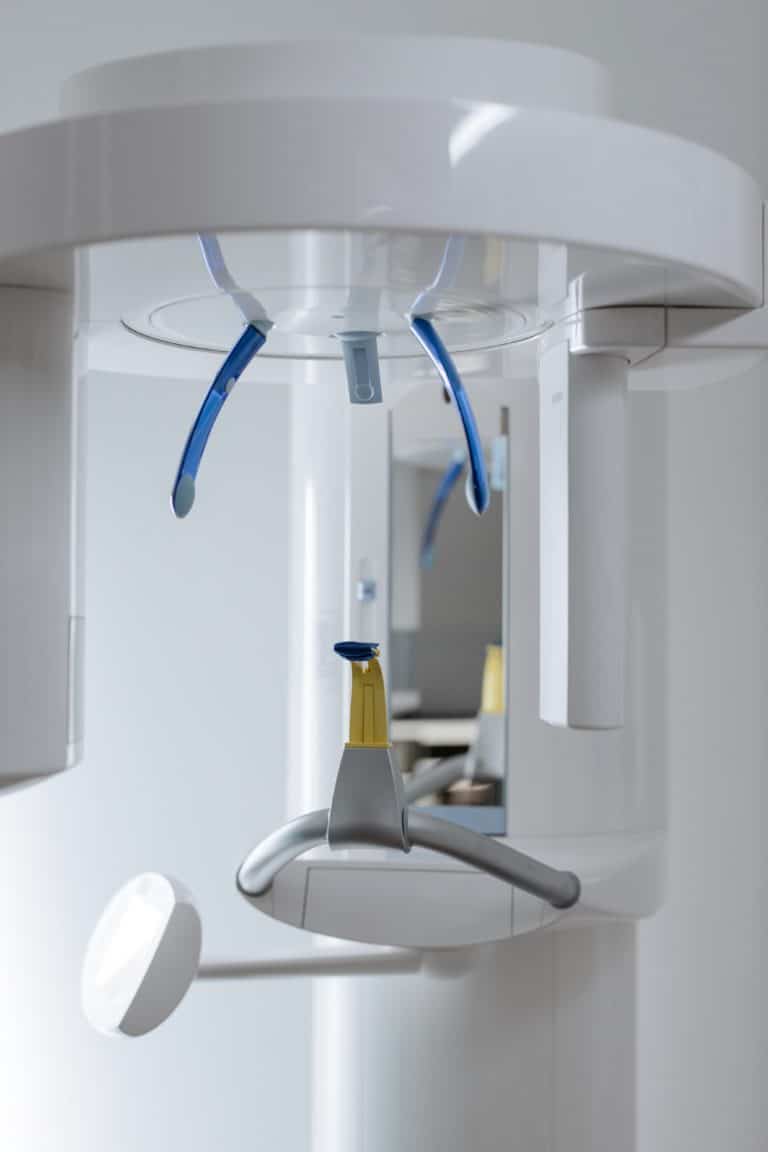
Cone Beam Computed Tomography
We will take a CT scan for each patient undergoing dental implant surgery to ensure that the implant can be placed in the most suitable alveolar bone position. The scan can also be used to determine whether a patient needs additional bone augmentation surgery.
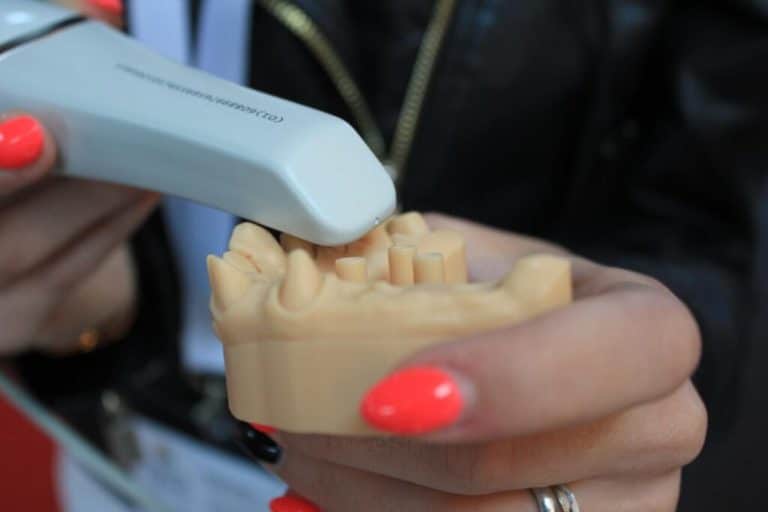
Digital Scanning
In order to accurately perform minimally invasive dental implant surgery, the doctor will first take an impression for the patient to make the cast to assist in the surgical operation. Dental casts also allow your doctor to understand your existing occlusal relationship, which can help your doctor design the right treatment plan for you.

Dental implant surgery
After completing the above steps, the doctor will perform a computerized surgery according to your situation and tailor a suitable surgical guide for you, which will take about two to three weeks. The next step is to perform dental implant surgery, where the titanium implant is placed inside the alveolar bone to heal.

Follow-up
Your doctor will arrange for you to come back for follow-up appointments two weeks after surgery to make sure the wound heals healthily.
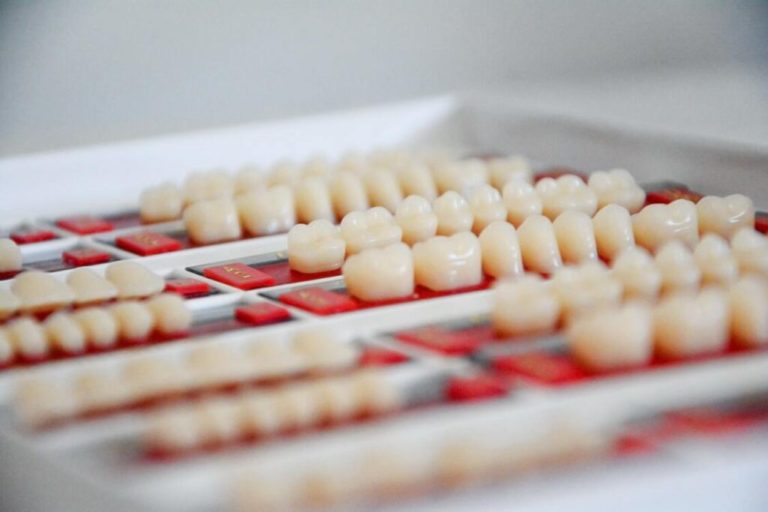
Implant impressions
You will need a follow-up visit after three months to perform an impression step on the implant to make the crown.
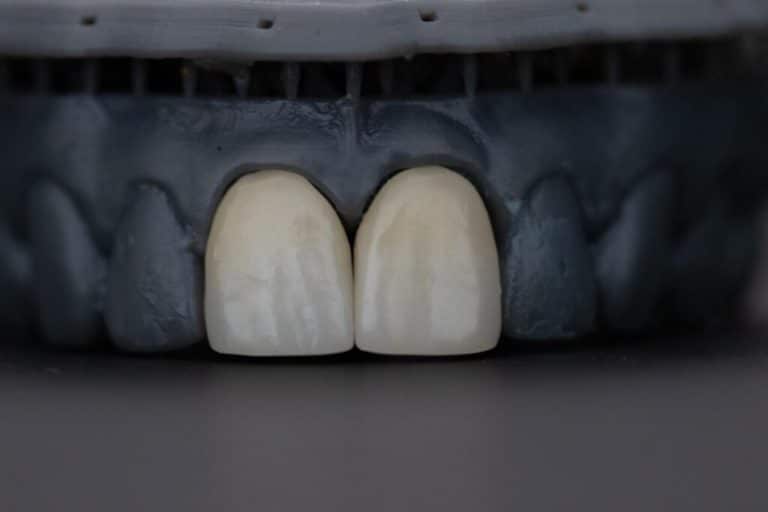
Attach a crown
The crown will be completed after two weeks and placed in your mouth for chewing and aesthetics. By this step, the implant is complete.

Follow-up
After the implant treatment is completed, your doctor will arrange regular follow-up visits to ensure that the implant is properly maintained.
Introducing Nixon Dental as Masters of Implant Dentistry
Nixon Dental stands as a beacon of excellence in the field of implant dentistry. With a commitment to delivering unparalleled oral care, Nixon Dental combines cutting-edge technology with a patient-centric approach. The skilled professionals at Nixon Dental understand the transformative power of dental implants, recognizing that each patient’s journey is unique.
The clinic’s reputation for precision and dedication to patient comfort has made it a trusted choice for those seeking reliable dental implant solutions. Whether addressing a single missing tooth or a more complex case, Nixon Dental tailors its approach to meet the specific needs and expectations of each individual.
The Nixon Difference: Why Choose Us?
Nixon Dental’s commitment to excellence extends beyond the surgical suite. The clinic’s skilled dentists, led by a team of experienced implant specialists, prioritize patient comfort and satisfaction. State-of-the-art facilities and personalized care define the Nixon difference, ensuring that each patient receives not only a restored smile but a renewed sense of confidence and well-being.
Decoding Dental Implants: Types, Advantages, and Realities Unveiled
In the realm of oral health, dental implants emerge as a transformative solution, bridging the gap between functionality and aesthetics. This exploration aims to unravel the essence of dental implants, shedding light on their definition, various types, and the unique advantages they offer compared to alternative options.
Defining Dental Implants: A Precision Art
At its core, a dental implant is a prosthetic device designed to replace missing teeth. Unlike traditional dentures, dental implants go beyond surface-level solutions, providing a long-lasting remedy that closely mimics the natural tooth structure. The primary component of a dental implant is a titanium post, surgically positioned into the jawbone, creating a robust foundation for the attachment of artificial teeth.
Exploring the Tapestry of Types
Dental implants come in various types, each tailored to cater to diverse patient needs. Endosteal implants, the most prevalent type, are directly embedded into the jawbone. Subperiosteal implants rest atop the jawbone, suitable for those with minimal bone height. Understanding these distinctions is pivotal for crafting personalized treatment plans that align with the individual’s unique oral anatomy.
Advantages of Dental Implants: A Symphony of Benefits
The allure of dental implants lies in their distinctive advantages, setting them apart as a preferred choice for tooth replacement.
- Seamless Aesthetics and Natural Feel
Dental implants seamlessly integrate with natural teeth, offering both a visually appealing and tactilely natural look and feel. This not only enhances the overall aesthetics of the smile but also bolsters self-confidence.
- Unmatched Stability and Durability
Unlike traditional dentures, dental implants provide unparalleled stability, eliminating concerns of slippage or shifting. Their durability ensures a long-lasting solution capable of withstanding the rigors of everyday use.
- Preserving Jawbone Health
One of the pivotal advantages of dental implants is their active role in preserving jawbone health. By stimulating bone growth, implants prevent bone loss, maintaining facial structure and overall oral health.
- Restoring Speech Clarity and Functionality
Dental implants contribute to clear speech and fully restored chewing and biting capabilities. This not only ensures improved functionality but also enhances the overall quality of life for those opting for this transformative solution.
Dispelling Myths: Navigating the Reality of Dental Implants
Despite the myriad benefits, dental implant HK often face misconceptions that can deter individuals from considering this effective solution.
- Affordability
Misconception: Dental implants HK are excessively expensive.
Reality: While the initial cost may be higher, the long-term benefits often make dental implants HK a cost-effective choice, with less need for replacements or adjustments.
- Pain and Discomfort
Misconception: Dental implant HK surgery is painful and involves significant discomfort.
Reality: Modern anesthesia and surgical techniques ensure minimal pain during the procedure, and postoperative discomfort is manageable with routine pain relief measures.
- Lengthy Recovery Period
Misconception: Recovery from dental implant HK surgery is lengthy and challenging.
Reality: While some recovery time is necessary, patients often resume normal activities relatively quickly. The duration varies based on individual cases and the complexity of the procedure.
- Unsuitability for Older Adults
Misconception: Dental implants HK are not suitable for older adults.
Reality: Age is not a strict determinant; as long as an individual is in good health, dental implant HK can be a viable option, offering improved oral function and quality of life.
Detailed Journey Through the Dental Implant Procedure
I. Preliminary Assessments and Consultations: Setting the Foundation
Before the surgical journey begins of dental implant procedure, a crucial initial step involves comprehensive assessments and consultations. This dental implant procedure phase is vital for both the dental professional and the patient, establishing the groundwork for a tailored treatment plan. Through thorough examinations, including dental imaging and health evaluations, the dentist gauges the feasibility of dental implants for the individual.
In the consultation process, patient expectations, concerns, and questions are addressed. Clear communication between the patient and the dental team is pivotal for a successful outcome, ensuring mutual understanding and cooperation.
II. Surgical Phase: A Step-by-Step Breakdown
- Anesthesia and Incision: Numbing the Path
As the surgical phase commences, the patient undergoes local anesthesia to ensure a pain-free experience. This crucial step not only ensures patient comfort but also allows the dental team to carry out the procedure with precision.
Following anesthesia, a meticulous incision is made at the designated site. The location and size of the incision depend on factors such as the number of implants and the specificities of the individual case. The goal is to expose the jawbone, creating a pathway for the implantation process.
- Implant Placement: Anchoring the Foundation
With the jawbone exposed, the dentist proceeds to the core of the procedure – implant placement. The dental implant, usually made of titanium, is carefully inserted into the jawbone. This step requires precision to ensure the implant integrates seamlessly with the bone structure.
The choice of implant type and size is determined by factors such as the patient’s oral anatomy, bone density, and the specific requirements of the case. The implant serves as a sturdy foundation for the artificial tooth or teeth that will be affixed in subsequent steps.
- Bone Grafting (If Necessary): Reinforcing the Structure
In some cases, individuals may require additional bone support to facilitate successful implant placement. This is particularly common in situations where natural bone density is insufficient. Bone grafting involves adding bone material to enhance the jawbone structure, providing a robust foundation for the implant.
The decision to perform bone grafting is made during the preliminary assessments, and its necessity is determined by the dentist based on factors specific to the individual’s oral health.
- Stitching and Healing Process: Nurturing the Transformation
Once the implant is securely in place, the incision is meticulously stitched to promote proper healing. The body’s natural healing processes then come into play, as the jawbone gradually fuses with the implant. This fusion, known as osseointegration, is a crucial phase that ensures the stability and longevity of the dental implant.
III. Post-Surgical Care and Recovery: Guiding the Aftermath
- Managing Discomfort and Pain: Nurturing Comfort
Post-surgical discomfort is a common concern, and effective pain management is paramount to ensuring a smooth recovery. Patients are provided with guidance on pain relief measures, including prescribed medications and at-home remedies. The dental team remains accessible for any postoperative concerns, emphasizing the importance of communication during this phase.
- Dietary Restrictions: Nourishing the Healing Process
During the initial stages of recovery, specific dietary restrictions are advised to support the healing process. Soft and easily chewable foods are recommended to minimize strain on the implant site. Adequate hydration and a balanced diet contribute to overall well-being and facilitate a faster recovery.
- Follow-Up Appointments: Monitoring the Progress
The journey doesn’t conclude with the surgery – follow-up appointments are integral to monitor the progress of the implant and address any emerging issues. These appointments allow the dental team to assess healing, adjust treatment plans if necessary, and ensure the patient’s continued comfort and satisfaction.
Deciphering the Financial Puzzle: Understanding Dental Implant Costs at Nixon Dental
I. Transparent Pricing Model: Building Trust Through Clarity
Nixon Dental stands firm in its commitment to transparency, offering a pricing model that eliminates ambiguity and hidden fees. This transparent approach serves as the foundation of trust between the clinic and its patients. By clearly outlining the costs associated with dental implant procedures, Nixon Dental empowers individuals to make informed decisions without the worry of unexpected financial surprises.
Understanding the transparent pricing model sets the stage for a collaborative and open partnership between patients and the dental team, fostering a sense of confidence and assurance throughout the implant journey.
II. Consultation Fees: A Preliminary Investment in Personalized Care
The journey to dental implants begins with a crucial step – the initial consultation. Nixon Dental recognizes the significance of this phase and charges consultation fees to cover comprehensive oral health assessments. During this consultation, the experienced dental team conducts thorough evaluations, discusses individual needs, and outlines potential treatment plans tailored to the unique requirements of each patient.
Consultation fees serve as an initial investment in personalized care, ensuring that the dental team has a clear understanding of the patient’s oral health and can craft a bespoke approach to the dental implant procedure.
III. Surgical Fees: Precision, Expertise, and Comprehensive Coverage
The core of dental implant costs lies in the surgical phase, where precision and expertise come into play. Nixon Dental’s surgical fees encompass the entire implant procedure, providing comprehensive coverage from the administration of anesthesia to the careful placement of the implant. This fee also includes any additional procedures deemed necessary during preliminary assessments, such as bone grafting.
The surgical fees reflect the skilled hands and advanced techniques employed by the dental team, ensuring a seamless and successful implantation process. It is a holistic charge that covers the entirety of the surgical journey, offering individuals the assurance of a thorough and professional approach.
IV. Additional Costs (If Applicable): Tailoring to Individual Needs
Recognizing the uniqueness of each individual’s oral health journey, Nixon Dental’s pricing model accounts for potential additional procedures. If bone grafting or other supplementary procedures are deemed necessary during preliminary assessments, the associated costs are transparently communicated to the patient.
Additional costs, if applicable, are a reflection of the personalized care provided by Nixon Dental. The clinic prioritizes tailoring the implant journey to meet the specific needs of each individual, recognizing that oral health is a nuanced and individualized aspect of overall well-being.
Cost Breakdown Note:
At Nixon Dental, the cost of a single dental implant is $18,000. However, for those opting for two or more dental implants, the cost per implant is reduced to $15,000. This comprehensive fee includes Osstem implants, consultation, CT scan, surgical expenses, and materials, along with the placement of artificial crowns.
Understanding the specifics of the cost breakdown ensures that individuals have a clear picture of the financial investment associated with their dental implant journey at Nixon Dental. It allows for informed decision-making and ensures that patients can approach the transformative process with confidence.
Frequently Asked Questions (FAQ)
A single dental implant at Nixon Dental is priced at $18,000. This dental implant cost covers the Osstem implant, consultation, CT scan, surgical expenses, and materials, providing a comprehensive overview of the implantation process.
Minimally invasive dental implants are a method recommended by implant dentists in recent years. It is a computed tomography scan that allows an implant to be accurately placed in the alveolar bone. Since it is a minimally invasive procedure, the time required for surgery is generally short (usually each tooth can be planted in about 15 minutes), and the wound is quite small, heals quickly, and there is less post-operative discomfort.
As fortraditional dental implants, the process is relatively complicated. It first requires surgery to insert the implant, then suture the gums, and then wait about 3 to 6 months before the second operation is performed, in which the gums on the implant are removed, and then a healing cap is attached to the implant to allow the gum wound on the implant to heal slowly, and then the impression is performed, and then the crown of the right size are made according to the model, and then installed on the implant.
The dental implants used in our dental clinic are titanium, while the main brands used in the clinic are Osstem Implants in Korea, Hiossen Implants in the United States and Straumann in Switzerland.
Rest assured, there will be no pain during the dental implant process. Because anesthetic injections are given before the implant procedure, you will not feel much during the implant.
In the following cases, the implant dentist recommends that you undergo dental implant treatment.
1) When one or more teeth are lost in the mouth
2) When the person with dental problems does not want to wear dentures, or his condition is not possible for dentures at all
3) When the oral condition is not suitable for traditional dentures
4) If the problem of teeth affects his ability to speak, or affects his ability to chew
In the above cases, it is advisable to undergo a detailed dental examination to determine the condition and undergo appropriate dental implant treatment.
First of all, avoid chewing hard foods such as peanuts and nuts. Although brushing teeth morning and evening is a designated action, it is also necessary to use dental floss or interdental brush to clean the location near the implant tooth. At the same time, the teeth should be checked regularly, about every 4 to 6 months. If you still have the habit of smoking, you should quit smoking as soon as possible to avoid periodontal disease and affect dental implants.
The dental implant HK procedure involves surgically placing a titanium post into the jawbone, serving as a foundation for artificial teeth. This post integrates with the jawbone, ensuring stability. Artificial teeth, typically crowns, are then affixed to the implants, replicating the natural look and functionality of teeth.
Nixon Dental stands out for its commitment to excellence, experienced team, and advanced facilities as dental implant HK. The clinic prioritizes personalized care, ensuring each patient’s unique oral health needs are met with precision. Utilizing Osstem implants, known for quality and durability, contributes to the success of dental implant procedures.
Yes, the dental implant cost savings for individuals opting for two or more dental implants. The dental implant cost per implant reduces to $15,000 for multiple implants, ensuring a more economical fee while maintaining high-quality standards.
Understanding financial considerations, Nixon Dental offers flexible dental implant cost options. These arrangements empower individuals to manage the financial commitment over manageable periods, making dental implants accessible to a broader spectrum of patients.
Several factors contribute to the dental implant cost, including the chosen implant material, the expertise of the dental surgeon, potential additional procedures like bone grafting, the clinic’s location in Hong Kong, and pre and post-operative expenses. All pricing is transparent.
The duration varies based on individual cases. Generally, the process involves consultations, assessments, surgery, and post-operative care. Nixon Dental’s experienced dental implant HK team ensures each stage is approached with precision, contributing to overall success.
Modern anesthesia minimizes pain during dental implant surgery. Postoperative discomfort is manageable with routine pain relief measures. Recovery varies, but patients are provided with guidance on managing discomfort, dietary restrictions, and follow-up appointments.
While coverage varies, Nixon Dental as dental implant HK team collaborates with patients to explore potential insurance benefits. The team works to maximize benefits, making dental implants feasible within insurance parameters.
Scheduling a consultation is simple – contact Nixon Dental via the official website or phone or WhatsApp to arrange an appointment. The experienced team conducts assessments, discusses needs, and outlines personalized treatment plans during consultations.



